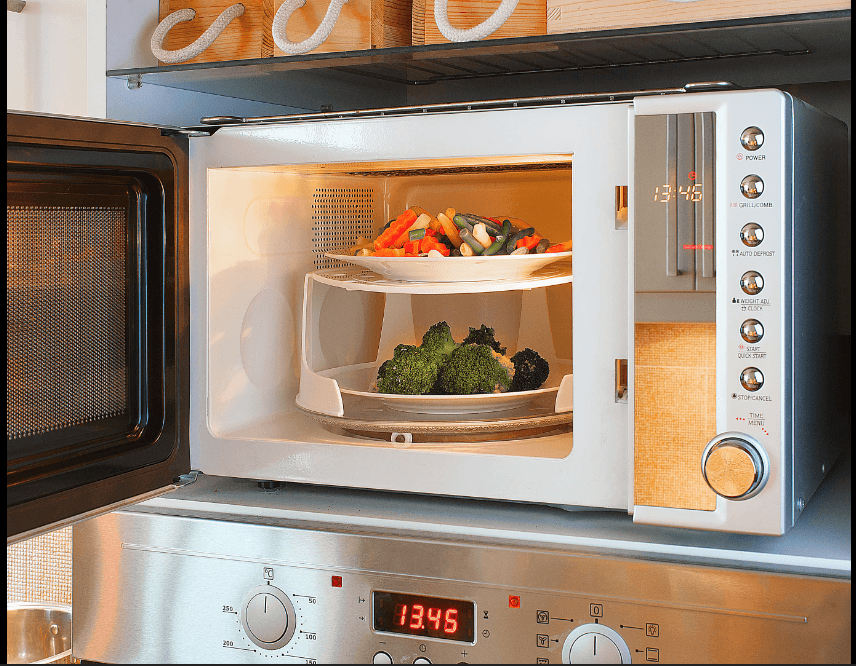Despite being an essential kitchen appliance for decades, few household items provoke more discussion than the microwave.
It is hailed as a lifesaver for those who can’t cook and portrayed by some chefs as being responsible for dragging the art of cooking into the gutter.
But there’s another debate besides culinary disputes – can the microwave do any harm? When used correctly, there is nothing to worry about in relation to microwave radiation, according to the World Health Organization (WHO).
However, other concerns are less clear, such as whether food loses nutrients or whether heating food in plastic containers can cause hormonal disorders.
Content
ToggleAfter all, does putting food in the microwave destroy nutrients?
Some research has shown that vegetables lose some of their nutritional value in the microwave.
For example, microwaving has been found to remove 97% of the flavonoids – compounds with anti-inflammatory benefits – from broccoli. That’s a third more than the loss caused by boiling.
A 2020 study compared the nutritional levels of a frozen ready meal prepared in the microwave and the same meal prepared in a conventional oven. The researchers found that the only difference between the two meals was that the one prepared in the microwave retained “a little” more vitamin C. But the researchers didn’t explain why this was.
A 2019 study that analyzed the loss of nutrients from broccoli in the microwave pointed out that previous studies varied the cooking time, temperature and whether or not the broccoli was in water.
And they found that shorter cooking times (they left the broccoli for one minute in the microwave) did not compromise the nutritional content.
Steaming and microwaving can even increase the content of most flavonoids, which are compounds linked to reducing the risk of heart disease.
“Under the cooking conditions used in this study, microwaving appeared to be a better way to preserve flavonoids than steaming,” the researchers wrote.
But they also found that too much water (such as the amount you would use to boil) in the microwave caused a drop in flavonoids.
It may be that it makes it easier to measure the flavonoids – perhaps by softening the plant tissue, making it easier to extract them – rather than increasing their quantity.
“Although in general the microwave is the preferred method, the ideal time will be different for different vegetables,” says Wu. “When considering commonly used home cooking methods, the microwave is the best cooking method, at least for many plant-based foods, but probably not for all.”
In another study, researchers compared the phenolic content (compounds associated with various health benefits) of various vegetables after being boiled, steamed and cooked in the microwave.
Microwaving and steaming caused a loss in the phenolic content of pumpkin, peas and leeks, but not spinach, peppers, broccoli or green beans. The researchers also tested antioxidant activity.
In both measurements, the vegetables performed better in the microwave compared to cooking.
“Moderate heat treatment may have been a useful tool for improving the properties of some vegetables,” the researchers wrote.
In a more recent study from 2023, microwaving also performed well. The researchers compared the impacts of boiling, steaming and microwaving different vegetables – and concluded that microwaving was the most effective at retaining nutrients.
Heating plastic
Is heating food in a plastic container in the microwave dangerous? We often microwave food in plastic packaging, but some scientists warn of the risk of ingesting phthalates. When exposed to heat, these plastic additives can break down and dissolve in food.
In a 2011 study, researchers bought more than 400 plastic containers designed to hold food – and found that most leaked chemicals that affect hormones.
They are known to affect hormones and our metabolic system. In children, phthalates can increase blood pressure and insulin resistance, which can increase the risk of metabolic disorders such as diabetes and hypertension.
Exposure to it has also been linked to fertility problems, asthma and Attention Deficit Hyperactivity Disorder (ADHD).
Phthalates are also potential thyroid hormone disruptors, says Leonardo Trasande, professor of environmental medicine and population health at NYU School of Medicine in New York. Among other things, these hormones are crucial for the development of babies’ brains during pregnancy.
Bisphenol (BPA) is also commonly used in plastic products. A 2020 review of studies concluded that BPA, when inhaled or ingested, can interfere with the behavior of cells and hormones by binding to receptors.
This, according to the researchers, can cause cancer, hormonal disorders, fertility problems and can also affect our immune system. But, they conclude, more research needs to be done. Currently, there is much more evidence about the effects of phthalates on health.
Phthalates are everywhere – even in toys and body lotions – and it’s still not clear how much harm they cause. But most experts agree that heating plastic with phthalates can increase exposure to them.
“Microwaving mobilizes contaminants,” says Rolf Halden, professor and director of the Biodesign Center for Environmental Health Engineering at Arizona State University. “This process is used in laboratories to extract pollutants from samples before chemical analysis.”
And the potential risks don’t increase according to how often someone heats something in the microwave, argues Trasande – since the relationship between the amount of chemical exposure and the risk of hormonal disruption is not linear.
It’s important to remember that when heating food in a plastic container, exposure can also occur with plastics that don’t touch the food, such as a lid.
“The water rises as steam from the food and then condenses on the underside of the lid, and the chemicals extracted from the lid fall onto the food, contained in the condensation droplets,” says Halden.
How can we minimize the risk?
The best ways to minimize the risk are to use materials other than plastic, such as ceramics. If you do use plastic containers, avoid ones that are losing their shape, as old and damaged containers are more likely to release chemical substances.
You can also check your container’s universal recycling symbol, usually on the bottom of the product – those with the number 3 and the letters “V” or “PVC” include phthalates.
Health risks
What about cooking or reheating food in the microwave?
Even if you avoid using plastic, there are other potential risks of heating food in the microwave – including uneven heating and the high temperatures used.
Firstly, think about using the microwave to heat rather than cook food, as it can cook unevenly. “Depending on the portion of food that is heated, there will be some parts that are hotter than others,” says Francisco Diez-Gonzalez, professor of food safety at the University of Georgia in the USA.
“The temperatures will be different in different parts of the food. It’s difficult to achieve a completely uniform temperature, especially when you’re talking about raw food.”
But it’s important to note that reheating food also poses risks. Food should be heated up to 82° C (176° F) to kill harmful bacteria, but as bacteria can still grow when food cools, you shouldn’t reheat a meal more than once.
High microwave temperatures can also pose some risk. Generally speaking, higher temperatures are not a problem, but there is research indicating a risk associated with cooking some starchy foods in the microwave, including cereals and root vegetables.
When Betty Schwartz, a professor of nutritional sciences at the Hebrew University of Jerusalem, saw her students heating up potatoes in the microwave during lunch, she noticed small crystals inside the potatoes.
When she analyzed them, she discovered that they were rich in the chemical acrylamide, which can be a natural by-product of cooking. Schwartz asked her students to boil their potatoes and found that this process did not create acrylamide, which she said forms at higher temperatures in the microwave.
This is a concern because animal studies have shown that acrylamide acts as a carcinogen because it interferes with the DNA of cells, but evidence in humans is limited. There is research to suggest that microwaves are more conducive to the development of acrylamide than other cooking methods.
But it’s important to note that reheating food also poses risks. Food should be heated up to 82° C (176° F) to kill harmful bacteria, but as bacteria can still grow when food cools, you shouldn’t reheat a meal more than once.
High microwave temperatures can also pose some risk. Generally speaking, higher temperatures are not a problem, but there is research indicating a risk associated with cooking some starchy foods in the microwave, including cereals and rice vegetables.
However, researchers have also found that a short exposure to microwaves – such as for defrosting – at low power can limit the formation of acrylamide when the food is then cooked.
“At 100°C, there is enough energy to alter the automatic joints between the molecules to produce a molecule with much more energy, which can cause a reaction with the DNA, which induces mutations,” says Schwartz. “When there are too many mutations, cancer can occur.” Animal studies have shown that this is the case with acrylamides.
One way around this is to soak the potatoes in water before putting them in the microwave.
Safe radiation
Microwave radiation is completely harmless. They use low-frequency electromagnetic radiation – the same kind used in light bulbs and radios. When you put food inside a microwave, it absorbs this radiation, which causes the water molecules in the food to vibrate, causing the friction that heats the food.
Humans absorb electromagnetic waves too. But microwave ovens produce relatively low-frequency waves that are contained in the oven. Even if this weren’t the case, the waves are harmless, says Tang. (Of course, the heat in a microwave is not harmless – so you should never put, for example, a living creature inside it).
“These microwaves are part of the electromagnetic waves to which we are exposed on a daily basis. When you bake bread, you are exposed to electromagnetic waves and infrared energy from the oven’s heating elements. Even people exchange radioactive waves with each other,” says Tang.
“If you eat things grown in sunlight, you shouldn’t worry about microwave food.”
Unlike X-ray machines, microwaves don’t use ionizing radiation, which means they don’t carry enough energy to separate electrons from atoms.
“You need to break the chemical bonds to damage the DNA. This is the main way radiation kills – it transforms cells and causes cancer,” explains Timothy Jorgensen, associate professor of radiation medicine at Georgetown University Medical Center.
Concerns about microwave radiation were largely clarified in the years after the invention of the microwave oven, adds Jorgenson.
CONCLUSION
Much research has been carried out by scientists at the Army Natick Research and Development Laboratories in Massachusetts, USA, into microwave safety, which has gone a long way towards easing concerns.
When it comes to cooking food in the microwave, there are many aspects to consider. They have been seen as a safe kitchen appliance – but there are caveats, according to research.
And in particular, experts are still raising concerns about how the plastic packaging we use in the microwave can affect our hormones and, consequently, our health.



